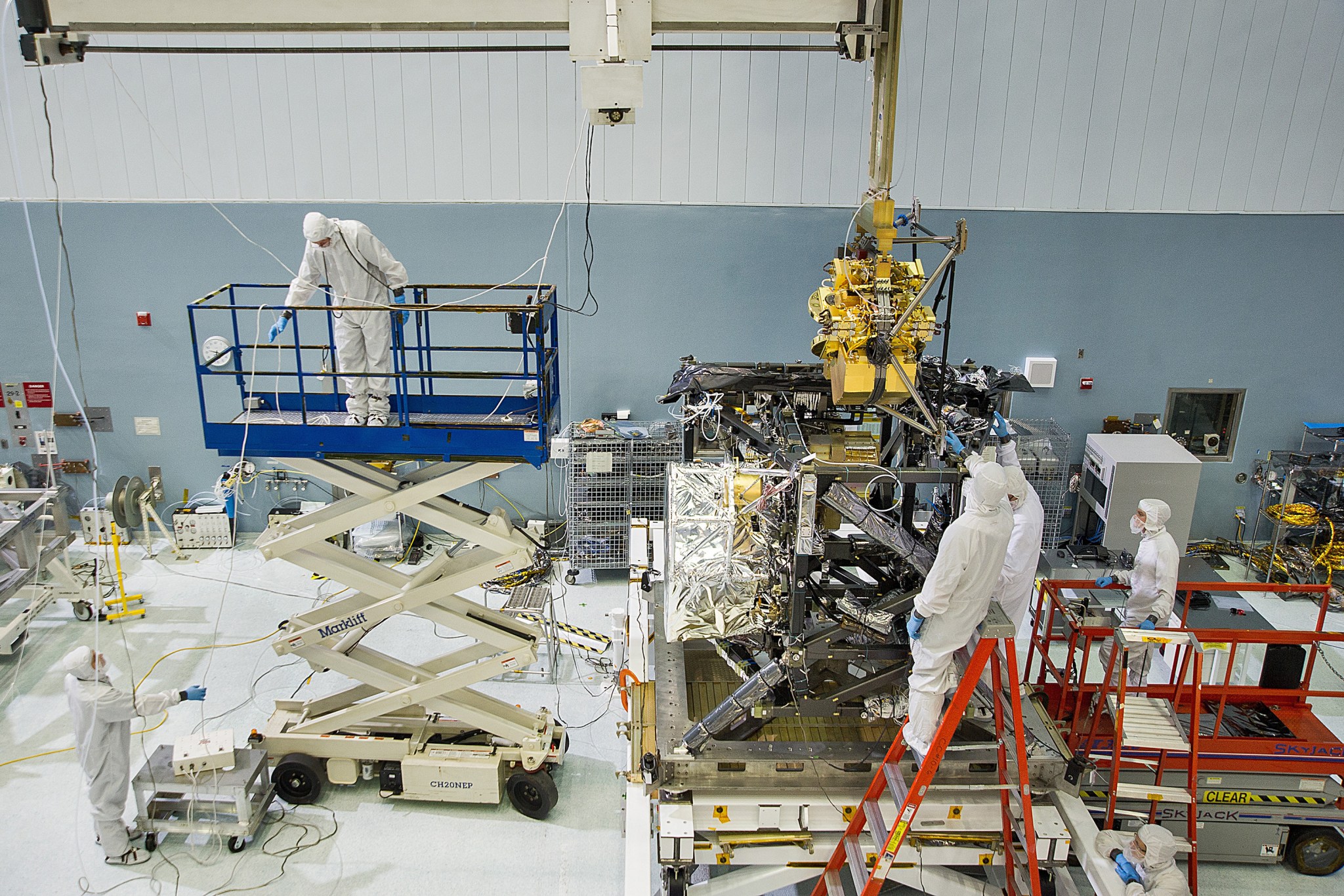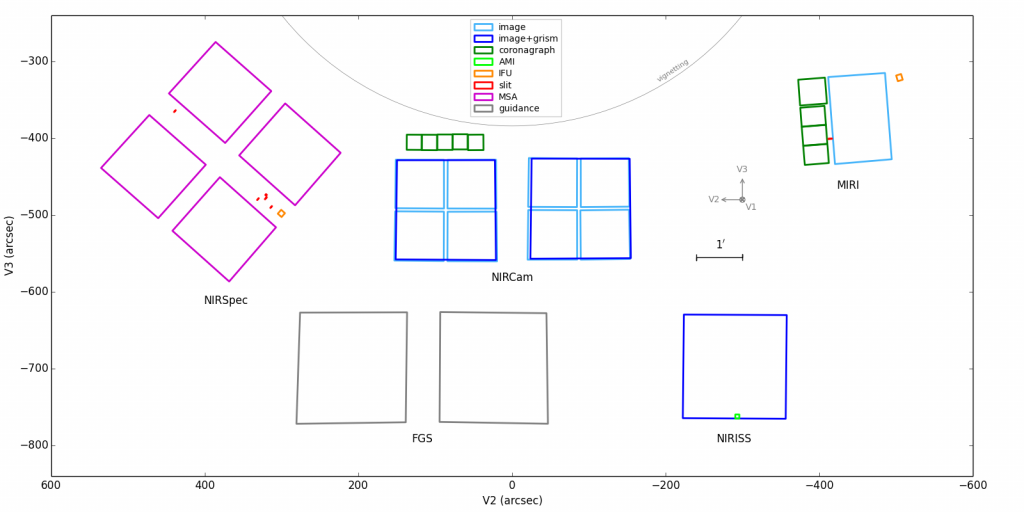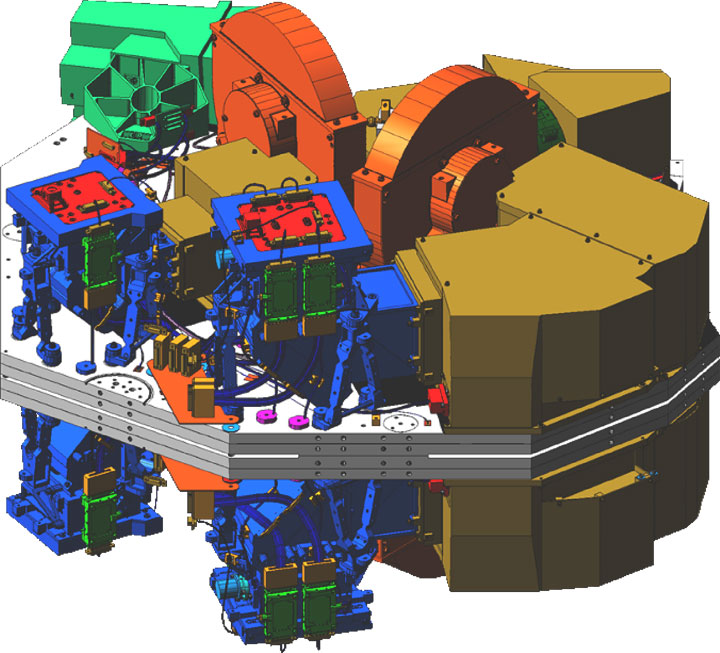Quick Facts
Near Infrared Camera (NIRCam)
NIRCam detects light from: the earliest stars and galaxies in the process of formation, the population of stars in nearby galaxies, as well as young stars in the Milky Way and Kuiper Belt objects. NIRCam is equipped with coronagraphs, instruments that allow astronomers to take pictures of very faint objects around a central bright object, like stellar systems.
In addition to imaging with a wide range of narrow, medium, and broad filters, NIRCam also offers wide field slitless (grism) spectroscopy and coronagraphic imaging modes, as well as time-series and grism time-series observing modes for high accuracy photometric monitoring and spectrophotometric monitoring, respectively.
NIRCam also obtains wavefront sensing measurements critical for periodic alignment and phasing of the segments of JWST's primary mirror. Webb’s wavefront sensing and control system detects and corrects for slight irregularities in the shape of the primary mirror or misalignment between mirror segments, giving the telescope the ability to focus clearly on objects near and far.
Because NIRCam is the only near-infrared instrument with coronagraphic and time-series imaging capabilities, it is crucial for many exoplanet studies. NIRCam's coronagraphs work by blocking a brighter object's light (for instance a star in a solar system), making it possible to view the dimmer object nearby (such as a planet orbiting that star). With the coronagraphs, astronomers hope to determine the characteristics of planets orbiting nearby stars.
Techical Description
The Near-Infrared Camera (NIRCam) is JWST’s primary imager in the wavelength range from 0.6 to 5 μm. It consists of two, nearly identical, fully redundant modules, which point to adjacent fields of view on the sky and can be used simultaneously. Each module uses a dichroic to also observe simultaneously in both the short wavelength channel (0.6 to 2.3 μm) and long wavelength channel (2.4 to 5.0 μm).
In addition to imaging with a wide range of narrow, medium, and broad filters, NIRCam also offers wide field slitless (grism) spectroscopy and coronagraphic imaging modes, as well as time-series and grism time-series observing modes for high accuracy photometric monitoring and spectrophotometric monitoring, respectively. NIRCam also obtains wavefront sensing measurements critical for periodic alignment and phasing of the segments of JWST's primary mirror.
Components
- Camera: captures two-dimensional images of regions of space.
- Spectrograph : spread light out into a spectrum so that the brightness of each individual wavelength can be measured.
- Coronagraph : opaque disks used to block the bright light of stars in order to detect the much fainter light of planets and debris disks orbiting the star..
Wavelength
NIRCam is designed to capture light ranging in wavelength from 0.6 microns (visible red) to 5 microns (mid-infrared).
Fields of View
An instrument’s field of view is the amount of sky that it can observe at any given point in time. (The actual area that can be observed depends on the distance of the object being observed.) In this graphic, a Hubble Space Telescope image of the Whirlpool Galaxy (M51) is shown for scale. The image covers an area of 9.6 × 6.6 arcminutes. (The full Moon has a diameter of about 31 arcminutes across the sky.) NIRCam has two main fields of view, each of which covers an area of 2.2 × 2.2 arcminutes. Its coronagraphic field of view is smaller.
Imaging Modes
- Standard: is the equivalent to basic digital photography and involves capturing pictures of a wide variety of objects and materials in space that emit or reflect infrared light.
- Coronagraphic: (sometimes called high-contrast imaging) involves using a coronagraph to block the light of a star in order to reveal the much dimmer light of nearby objects, such as exoplanets and debris disks.
- Time-series: involves capturing a series of images at regular intervals in order to measure changes over time. Time-series can be used to track changes in the brightness of a star or can be combined with coronagraphic imaging to track the motion of a planet.
Spectroscopy Modes
- Wide-field slitless Spectroscopy: involves capturing the overall spectrum of a wide field of view: a field of stars, part of a nearby galaxy, or many galaxies at once.
- Time-series Spectroscopy: involves capturing the spectrum of an object or region of space at regular intervals in order to observe how the spectrum changes over time. Time-series spectroscopy is used to study planets as they transit their stars.
NIRCam Development Gallery
Gallery of the development, testing and commissioning of the NIRCam in reverse chronological order.
The image below is a SLIDESHOW. Hover over the image to see the image title and controls. Click the image to go to a detail page with more info and the ability to download the image at various resolutions (click downward arrow in lower right corner).
Video: NIRcam 3d Diagram Rotation
NIRCam Development Team
NIRCam was developed by a team at the University of Arizona and Lockheed Martin’s Advanced Technology Center, led by Principal Investigator Marcia Rieke from the University of Arizona.






































